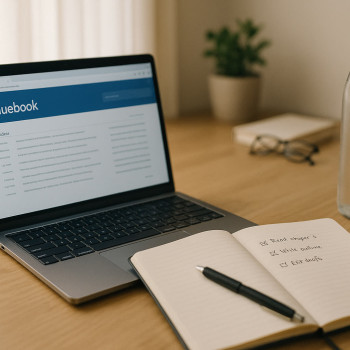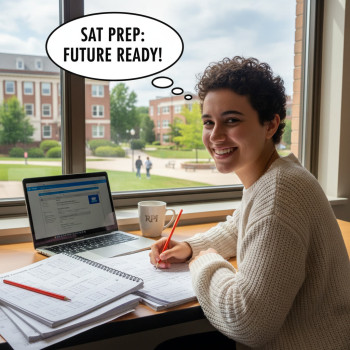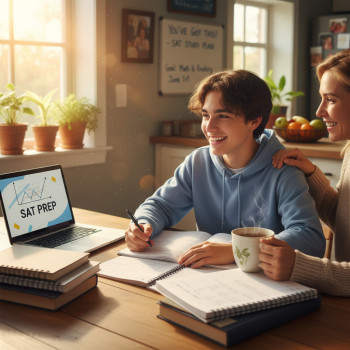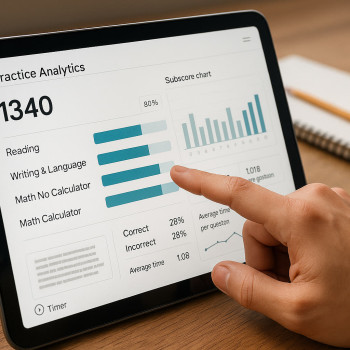Why Scientific Literacy Matters on the SAT
If you’ve ever opened an SAT Reading section and felt a little shaky when the passage turned into a discussion of ecosystems, climate models, or a psychology experiment, you’re not alone. Scientific passages are a recurring and often intimidating part of the test. But here’s the secret: you don’t need a biology degree or a lab coat to conquer them. What you need is scientific literacy—a set of reading and thinking skills that lets you follow an argument, interpret data, and judge evidence. Those skills are exactly what the SAT tests.
Scientific literacy on the SAT isn’t about memorizing facts. It’s about recognizing how scientific claims are constructed, understanding the language scientists use, and seeing how evidence supports conclusions. When you build this fluency, science passages stop feeling like a wall of jargon and start looking like puzzles you can unpick. That makes you faster, more accurate, and much more confident on test day.
What “Scientific Literacy” Looks Like in the SAT Reading Section
Let’s break down what we mean by scientific literacy in a way that’s practical for SAT prep. These are the skills you’ll use, over and over, whenever a passage discusses research, experiments, or data.
- Understanding structure: Identifying hypotheses, methods, results, and conclusions. SAT writers often present an experiment and then ask about the author’s interpretation.
- Interpreting data and visuals: Reading small tables or described data trends, recognizing what a correlation or a change over time implies.
- Evaluating evidence: Distinguishing between strong, directly relevant evidence and anecdotal, weak, or irrelevant examples.
- Decoding technical terms: Using context to infer the meaning of a scientific term you haven’t seen before.
- Recognizing uncertainty: Spotting qualifiers—words like may, likely, suggests—that change the strength of a claim.
Master these, and you’ll navigate science passages with the same confidence you bring to a literary passage.
Why the SAT Uses Science Passages
The SAT aims to measure reasoning skills that are useful in college and beyond. Science passages are particularly effective for testing critical reading because they demand both conceptual and evidence-based thinking. A passage about an experiment forces you to weigh methods and conclusions. A passage about climate or ecology asks you to follow probabilistic reasoning and projections. Those cognitive moves—evaluating a claim, connecting evidence to conclusions, and translating a complex description into a concise interpretation—are exactly the ones the SAT rewards.
In short: science passages show how you think, not just what you know. Developing scientific literacy sharpens that thinking.
Key Scientific Concepts Frequently Tested on the SAT
Here are the recurring concepts that appear in science-rich passages, with short explanations of why they matter for reading comprehension.
- Hypothesis and prediction: Authors often set up a claim and predict what data would show if it’s true. Recognizing the prediction helps you evaluate whether the results support the claim.
- Variables and controls: Identifying what changed in an experiment and what stayed the same prevents you from misreading causal claims.
- Correlation vs. causation: A classic trap. Many passages describe a relationship between two variables; the stronger answer choices carefully distinguish correlation from proven causation.
- Sample size and representativeness: Small or biased samples weaken conclusions—an important clue when the author’s argument depends on data quality.
- Margin of error and statistical significance (in simplified form): Authors may talk about whether results are meaningful. You don’t need complex math, just the idea that not all variation is important.
Practical Reading Strategies Built on Scientific Literacy
Now for the good part: how to apply scientific literacy while you’re actually taking the SAT. These tactics are fast, test-friendly, and evidence-based—perfect for building into practice tests and study sessions.
1) Map the experiment
When you see a passage describing a study, quickly jot a three-part note: hypothesis, method, result. This 3-line map takes 5–10 seconds and saves time when questions ask you to evaluate methods or results.
2) Circle qualifiers and direction words
Pick out words like might, suggests, little, increases, decreases, and compared to. They’re key to understanding how strong the author’s claims are and whether a statement in an answer choice is too strong.
3) Translate jargon into plain English
If a paragraph reads like dense technical prose, rewrite one sentence in your own words in the margin. Often the SAT is testing your ability to distill a dense idea to its essence, not to know specialized vocabulary.
4) Use evidence-first answers
When choosing between answers, prefer the option that ties directly to evidence in the passage. If an answer introduces outside info that’s not in the text, it’s likely wrong. This is where scientific literacy helps: you can tell whether the passage’s data actually supports the claim.
5) Look for alternative explanations
Good science writing often lists caveats. If the author mentions potential alternate explanations, watch for questions about assumptions or limitations. Those are high-yield question types on the SAT.
Interpreting Data and Tables: A Short Guide
Occasionally a passage will describe data that you need to interpret. Even when the SAT doesn’t show a literal graph, authors will describe trends and comparisons. Here’s a compact toolkit for translating that description into actionable answers.
- Identify the baseline: What is being compared to what? Time, groups, or conditions?
- Check direction and magnitude: Does something increase or decrease, and by how much? Words like substantially or slightly are meaningful.
- Watch for qualifiers: ’No significant change’ versus ‘a small change’ convey different scientific weights.
- Relate back to the claim: Do the data directly support the author’s conclusion, or do they merely suggest it?
To make this concrete, below is a simple table that shows how different kinds of evidence change the strength of a claim.
| Type of Evidence | What It Shows | How Strong It Is |
|---|---|---|
| A single small-sample study | Limited support, possible anomalies | Weak |
| Multiple independent studies with similar results | Consistent support across contexts | Strong |
| Observational correlation | Shows association but not cause | Moderate |
| Controlled experiment with clear causal mechanism | Direct evidence for causation | Very strong |
Sample Mini-Passage and Practice Questions
Trying a short, original practice passage and questions is one of the best ways to internalize scientific reading skills. The passage below is brief and designed to mimic the SAT style. Read it, then answer the questions that follow. You can check your reasoning against the explanations afterward.
Passage (original): A team of researchers investigated whether daily exposure to urban green spaces affects short-term cognitive performance. They compared two groups: a group of high school students who walked for 20 minutes each day through a tree-lined park, and a group who walked for the same time through an urban street with no vegetation. The researchers administered a standardized attention test before and after the two-week period. The park group showed a small average improvement in attention scores, while the street group showed no change. The researchers concluded that regular exposure to green space may modestly improve short-term attention in adolescents, but noted that their sample size was small and that socioeconomic differences between neighborhoods could influence the results.
Questions
- 1. Which of the following would most weaken the researchers’ conclusion that green space may improve attention?
- 2. The phrase “may modestly improve” in the conclusion most closely indicates which of the following?
- 3. If you wanted to test whether green space causes lasting improvements in attention, which change to the study would be most important?
Answers and Explanations
1. The strongest weakening evidence would be a follow-up study showing that when students from the same neighborhood are randomly assigned to park walks or street walks, both groups show similar attention changes. Why? That would eliminate the neighborhood-socioeconomic explanation and the small-sample anomaly—undermining the claim that green space itself caused the change.
2. The phrase “may modestly improve” signals caution and limited effect size. It indicates uncertainty and restraint; the researchers are not claiming a large or definitive effect. On the SAT, answer choices that make absolute claims would be wrong; choose the answer that reflects tentative, small-scale improvement.
3. To test for lasting (not just short-term) improvements, extend the study duration and include follow-ups after a longer interval. Also, random assignment and larger, diverse samples would strengthen causal inference. The SAT often tests whether you can identify methodological improvements that increase causal clarity.
Practice Habits That Build Scientific Literacy Fast
Scientific literacy is a skill set—you build it through targeted practice. Here’s a weekly practice plan you can adapt to your schedule. Do it consistently for several months and you’ll see real improvement.
- Daily (15–30 minutes): Read a short science article or the methods section of an accessible study. Summarize the hypothesis, method, result, and limitation in one sentence each.
- 3 times a week (30–60 minutes): Do SAT Reading passages that include science content. Use the mapping and qualifier strategies described above.
- Weekly (60–90 minutes): Work through a longer practice test section and review every incorrect answer by identifying whether your error was conceptual (misreading evidence) or strategic (time, careless).
- Monthly: Take a full practice SAT and simulate test timing. Track progress in a notebook—look for trends in question types you miss most often.
How Tutoring Can Accelerate the Process — Naturally Mentioning Sparkl’s Role
Some students make faster gains with guided support. A tutor can help you turn general strategies into personalized habits: pinpoint your misunderstandings, provide targeted passages that address your weak spots, and offer realistic pacing strategies for test day. If you’re considering outside help, a service like Sparkl’s personalized tutoring can fit naturally into this process. With 1-on-1 guidance and tailored study plans, an expert tutor can quickly identify whether your difficulty is conceptual (for example, misreading experimental controls) or tactical (such as poor time management). Sparkl’s tutors often combine expert teaching with AI-driven insights—helping you track progress and adapt study sessions to what actually moves your score.
That said, tutoring is most effective when paired with consistent practice. Use a tutor to accelerate feedback loops: do a timed passage, get targeted instruction on your mistakes, then immediately apply the correction in follow-up practice.
Common Mistakes Students Make with Science Passages
Awareness of common pitfalls helps you avoid them. Here are errors I see repeatedly, with quick fixes you can apply in practice.
- Misreading correlation as causation: Fix: Ask, “Did the study manipulate variables or only observe them?” If not manipulated, avoid causal answer choices.
- Over-relying on prior knowledge: Fix: Anchor your answers strictly to passage evidence. The SAT rewards what’s in the text, not what you know outside it.
- Ignoring qualifiers: Fix: Circle or underline qualifying words the moment you see them and let them guide your answer choices.
- Getting lost in jargon: Fix: Translate a complex sentence into one clear clause in the margin before moving on.
- Letting tables or descriptions intimidate you: Fix: Identify the baseline and the trend in one sentence; most data-related questions ask about direction or relative magnitude.
How to Use Practice Tests to Measure Scientific Literacy Growth
Not all score gains are created equal. Instead of only tracking raw scores, measure your growth in specific skill areas related to scientific literacy. Create a simple tracking table in your study journal with columns like: question type, time taken, correct/incorrect, error reason, and notes. After 4–6 weeks, look for patterns. Are you consistently missing questions about methods? Are data-interpretation questions taking much longer than average? This diagnostic approach helps you prioritize study time.
Comparing Reading a Science Passage to a Lab Notebook
Here’s a short metaphor that helps many students: treat a science passage like a lab notebook. The author’s hypotheses are the lab’s research question. The method section is the experiment protocol. Results are the raw data, and the conclusion is the researcher’s interpretation. When you read like a scientist—questioning whether the method actually tests the hypothesis—you’re doing the kind of active reading the SAT rewards.

Putting It All Together: A 6-Week Mini-Plan
This six-week schedule is for students who want steady improvement without burning out. Each week combines strategy practice, timed passages, and reflection.
- Weeks 1–2: Focus on mapping experiments, translating jargon, and circling qualifiers. Do 3 science passages per week and write short 3-line maps for each.
- Weeks 3–4: Add data interpretation practice—translate described trends into one-sentence summaries. Begin timed practice sections once per week.
- Weeks 5–6: Simulate full timed sections and apply targeted review. If you work with a tutor (for example, through Sparkl’s personalized tutoring), use these weeks to refine pacing and solve persistent error patterns with 1-on-1 guidance and AI-driven progress reports.
Final Encouragement and Real-World Perspective
Scientific literacy is a practical, portable skill. It helps not only on the SAT but also in college classes, in consuming news responsibly, and in making decisions informed by evidence. Getting better at reading scientific passages is less about instant genius and more about deliberate practice. Read deliberately, test intentionally, and reflect on your errors—you’ll see steady gains.
Remember: progress doesn’t have to be dramatic overnight. Small improvements in how you spot a qualifier or map an experiment add up quickly. With consistent practice, the next time you enter the Reading section you’ll look at a science passage and think: “Okay—this is manageable.” That confidence itself improves accuracy.
If you want to accelerate that progress, targeted help—like personalized 1-on-1 tutoring, tailored study plans, and expert feedback—can make your practice more efficient. Sparkl’s personalized tutoring model, which blends expert tutors with adaptive insights, is specifically designed to do just that: help you focus on the precise skills that move your score.
Next Steps
Start small: pick one strategy from this article—map experiments, circle qualifiers, or summarize data trends—and apply it to three passages this week. Track how your accuracy and speed change. Over time, layer in another practice habit and continue building. With consistent effort, scientific passages will stop being the part of the test you dread and become the part you outperform others on. Good luck—and enjoy the process of getting smarter about science and reading.














No Comments
Leave a comment Cancel